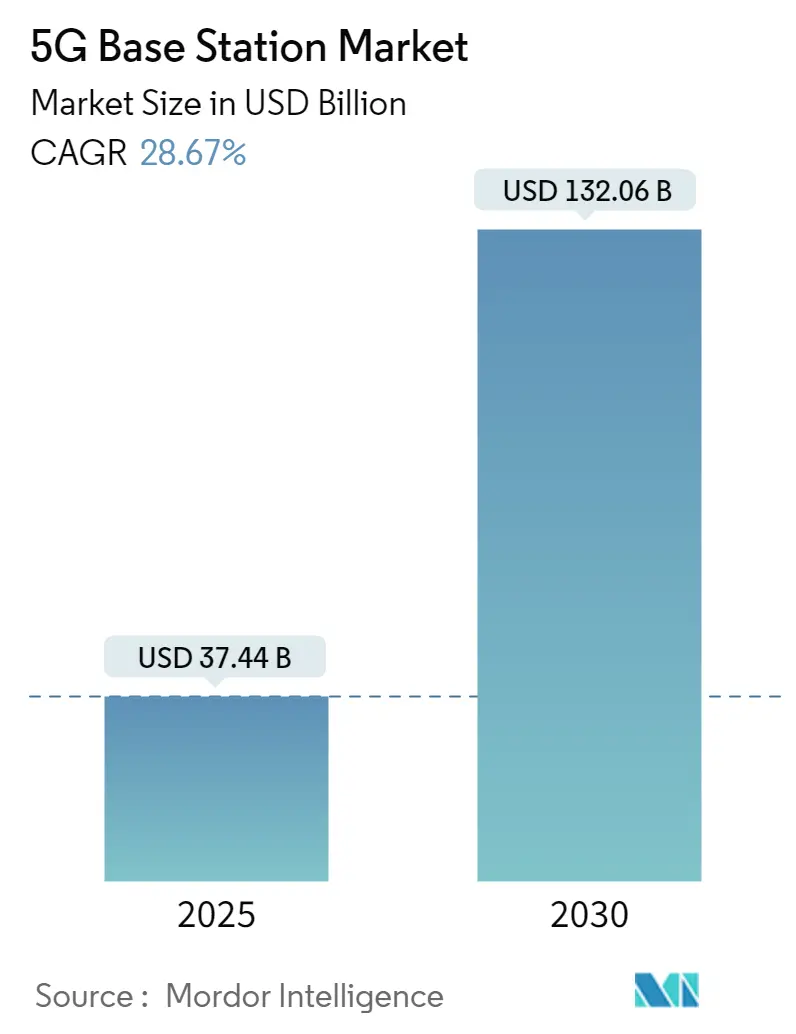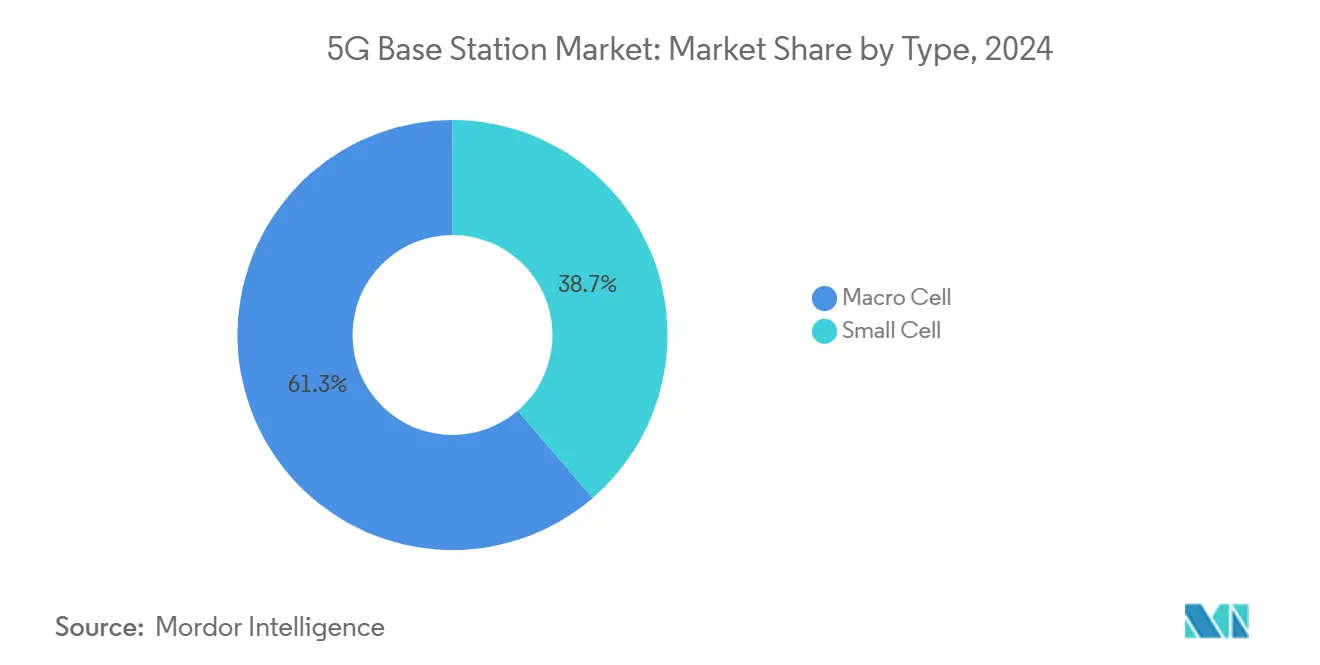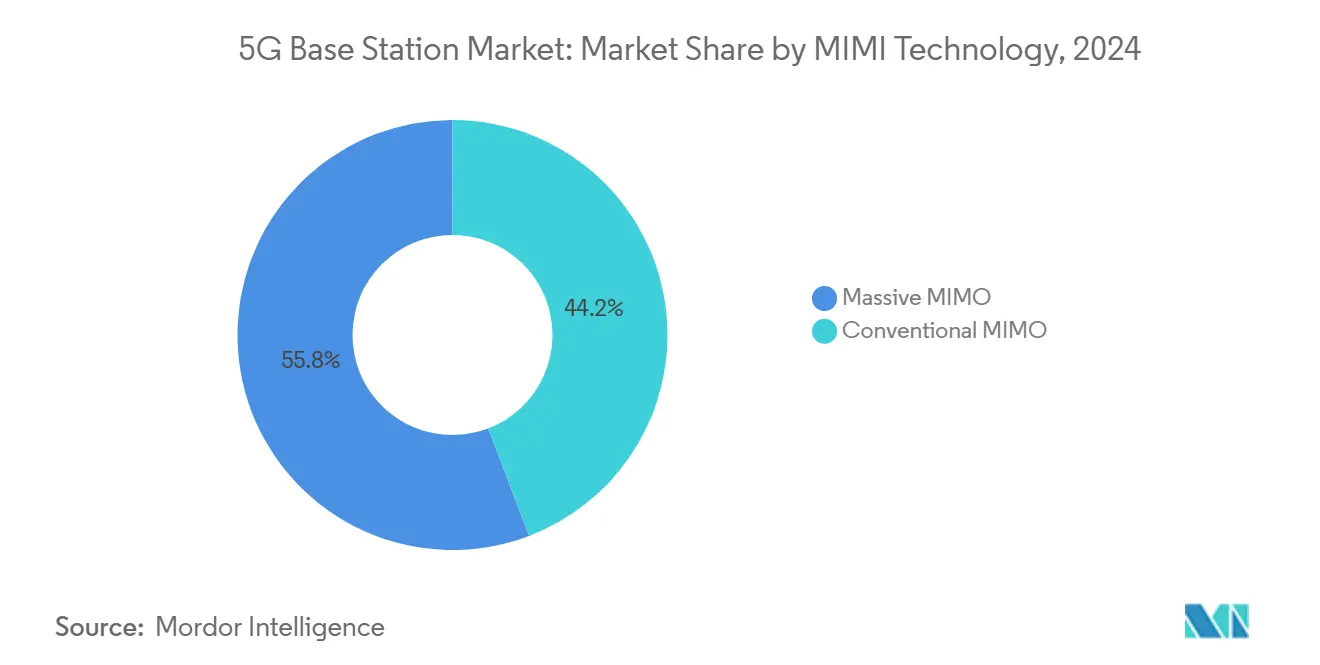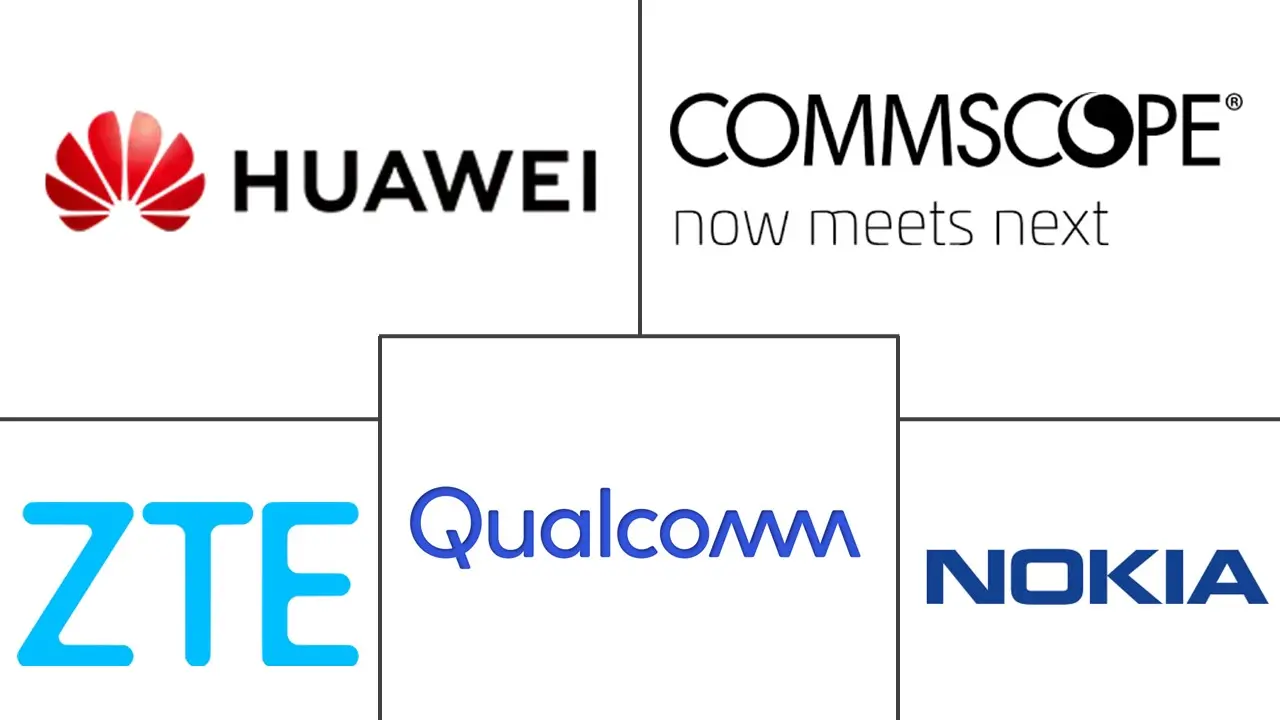5G Base Station Market Size and Share

5G Base Station Market Analysis by Mordor Intelligence
The 5G Base Station Market size is estimated at USD 37.44 billion in 2025, and is expected to reach USD 132.06 billion by 2030, at a CAGR of 28.67% during the forecast period (2025-2030).
Robust growth stems from governments turning spectrum auctions into infrastructure stimulus, operators upgrading to Open-RAN, and enterprises seeking ultra-reliable low-latency connections for automation and public-safety systems. China already operates more than 4.4 million live sites, while the United States and key European markets emphasize open architectures to cut vendor risk and spur innovation. Supply-chain diversification has become urgent after recent semiconductor shortages, pushing vendors to add regional manufacturing and gallium-nitride power amplifiers that lower energy bills by up to 50% at each site. Demand for private networks in smart factories, ports, and smart-city corridors further accelerates densification with small cells, massive-MIMO radios, and millimeter-wave nodes.
Key Report Takeaways
- Macro cells led with 61.3% revenue share in 2024 and small cells are advancing at a 29.4% CAGR through 2030.
- Non-standalone architecture accounted for 58.7% of the 2024 total while standalone is expanding at a 30.1% CAGR to 2030.
- Sub-6 GHz frequencies commanded 64.2% share in 2024 yet the mmWave segment is growing at a 28.7% CAGR.
- High-power (≥40 W) platforms held 52.6% share in 2024 and low-power (≤10 W) systems are posting a 27.9% CAGR.
- Massive-MIMO captured 55.8% share in 2024 and tops growth at a 30.4% CAGR.
- Commercial mobile operators represented 59.1% of end-user spending in 2024 while smart-city and public-safety deployments are rising at a 28.9% CAGR.
- Asia-Pacific dominated with 41.6% regional share in 2024 and the Middle-East and Africa region is climbing at a 30.2% CAGR.
Global 5G Base Station Market Trends and Insights
Drivers Impact Analysis
| Driver | (~) % Impact on CAGR Forecast | Geographic Relevance | Impact Timeline |
|---|---|---|---|
| Rising mobile data traffic and smartphone penetration | +8.2% | Global with peak impact in APAC and Latin America | Medium term (2-4 years) |
| Superior latency and bandwidth advantages of 5G | +6.1% | Global concentrated in developed markets | Long term (≥4 years) |
| Government spectrum auctions and infrastructure stimulus | +5.8% | North America, Europe, select APAC markets | Short term (≤2 years) |
| Open-RAN driven brown-field upgrade cycle | +4.3% | Europe and North America with expansion into APAC | Medium term (2-4 years) |
| mmWave small-cell roll-outs for private industrial 5G | +2.9% | Industrial hubs in the United States, Germany, Japan, South Korea | Long term (≥4 years) |
| Energy-efficient GaN power amplifiers cutting site OPEX | +1.4% | Global with early uptake in cost-sensitive markets | Medium term (2-4 years) |
| Source: Mordor Intelligence | |||
Government Spectrum Auctions and Infrastructure Stimulus
Governments are turning spectrum sales into policy tools that expand coverage and local manufacturing. The United States allocated USD 42.45 billion under the Infrastructure Investment and Jobs Act, targeting rural broadband and 5G build-outs in underserved counties. India’s USD 12 billion Production-Linked Incentive scheme rewards domestic production of radios and antennas, shortening supply chains and accelerating rural rollouts. Stable auction roadmaps and subsidy programs give operators cash-flow visibility that unlocks multi-year investment cycles and lifts the 5G base station market across both macro and small-cell layers. [1]“Fact Sheet: Bipartisan Infrastructure Law Boosts Broadband,” White House, whitehouse.gov
Open-RAN Driven Brown-Field Upgrade Cycle
Open-RAN disaggregates radios, baseband, and software so carriers can blend best-of-breed vendors, slash procurement cost, and automate updates. Vodafone committed to swapping 2,600 United Kingdom sites to Open-RAN by 2027, targeting 30% cost savings and broader supplier diversity. Deutsche Telekom is extending multivendor trials across Germany and Poland to raise flexibility and spur domestic innovation. Although system integration remains complex, early commercial launches validate performance and are influencing procurement criteria for upcoming densification waves, boosting the 5G base station market. [2]Vodafone Group, “Open-RAN progress update,” vodafone.com
mmWave Small-Cell Roll-Outs for Private Industrial 5G
Millimeter-wave nodes deliver fiber-like data rates and sub-millisecond latency inside plants and logistics hubs. Toyota has equipped multiple vehicle-assembly lines with private 5G at 28 GHz to enable synchronized robotic welding, streaming analytics, and predictive maintenance. Cummins leverages mmWave to support augmented-reality quality checks requiring high-definition video uplinks. The productivity gains offset higher hardware cost, making mmWave a preferred channel for secure, high-throughput industrial traffic that cannot coexist on public macro layers. [3]“Toyota trials private 5G at manufacturing sites,” Toyota Motor Corp., toyota.com
Energy-Efficient GaN Power Amplifiers Cutting Total Site OPEX
Gallium-nitride amplifiers operate at higher voltages and temperatures than legacy silicon, raising RF efficiency and shrinking cooling needs. Qorvo measured up to 50% lower electricity bills at live macro cell sites after retrofitting GaN lineups, translating into meaningful lifetime savings for power-price-sensitive operators. Wolfspeed has ramped epi-wafer supply and signed multiyear contracts with leading OEMs to de-risk component scarcity. As energy costs escalate, power-optimized radios become a procurement priority that lifts refresh demand in mature footprints.
Restraints Impact Analysis
| Restraint | (~) % Impact on CAGR Forecast | Geographic Relevance | Impact Timeline |
|---|---|---|---|
| High CAPEX and long ROI horizon | –4.2% | Global with acute impact in emerging markets | Long term (≥4 years) |
| Spectrum fragmentation and regulatory delays | –2.8% | Europe, Latin America, select APAC markets | Medium term (2-4 years) |
| RF-front-end component supply bottlenecks | –2.1% | Global and most severe in high-volume deployments | Short term (≤2 years) |
| Sustainability compliance inflating site costs | –1.6% | Europe and North America with global spillover | Medium term (2-4 years) |
| Source: Mordor Intelligence | |||
High CAPEX and Long ROI Horizon
Operators face multi-billion-dollar rollouts with longer payback than prior network generations. Verizon disclosed spending above USD 10 billion per year on 5G radios and fiber backhaul and estimates a seven-to-ten-year return window versus about five years for LTE. Rural projects are even less economical, forcing carriers to focus on dense urban clusters unless subsidies cover viability gaps. The stretched cash cycle tempers the pace of nationwide coverage and limits 5G base station market expansion in lower-income countries.
RF-Front-End Component Supply Bottlenecks
Lead times for high-frequency filters and power amplifiers breached 52 weeks during recent semiconductor shortages, directly capping base-station output. Broadcom continues allocation on select die used for mmWave arrays while Skyworks balances telecom, automotive, and industrial demand for scarce gallium-arsenide wafers. Vendors have redesigned some boards to fit alternative parts but added engineering cost and delayed revenue recognition. Component tightness remains a near-term ceiling on the 5G base station market until fresh foundry capacity and material supplies normalize.
Segment Analysis
By Type: Small Cells Accelerate Urban Densification
Macro cells represented USD 22.9 billion and 61.3% of the 2024 5G base station market share, providing umbrella coverage and mobility anchor services. Yet small cells are forecast to expand at a 29.4% CAGR, pushing their slice of the 5G base station market size toward USD 50 billion by 2030. Carriers deploy thousands of street-level nodes to relieve macro congestion in sports venues, transit corridors, and enterprise campuses. Verizon alone installed more than 50,000 low-power units that fill indoor dead zones and enable symmetrical gigabit rates.
Permitting challenges and aesthetic restrictions once hampered small-cell scaling, but streamlined Federal Communications Commission rulings shortened municipal review from several months to under 60 days. Private networks further lift demand because small cells create dedicated on-premises coverage without relying on public spectrum. Vertical asset owners such as Crown Castle now report triple-digit growth in signed indoor contracts, underscoring how densification underpins the global 5G base station market.

By Architecture: Standalone Adoption Gains Momentum
Non-standalone deployments still held 58.7% share in 2024 as operators leveraged existing LTE cores for quick service launches. However the standalone cohort is maintaining a steep 30.1% CAGR, and its share of the 5G base station market size will exceed 60% by 2030. ATandT activated standalone slices for industrial clients needing deterministic latency, while T-Mobile extended nationwide standalone coverage that enables differentiated performance tiers.
Standalone architecture unlocks network slicing, distributed edge computing, and advanced encryption that non-standalone cannot deliver. Dish Network avoided legacy anchors and built an entirely cloud-native network, demonstrating lower operating expenses and rapid feature release cycles. Although core migration raises complexity and skills requirements, operators recognize the long-term revenue upside, accelerating orders for compatible radios and core software.
By Frequency Band: mmWave Broadens Its Use-Case Set
Sub-6 GHz remained the workhorse with 64.2% share in 2024 because of better reach and penetration, but mmWave shipments are forecast to rise at 28.7% CAGR. Fixed wireless access offerings from Verizon deliver multi-gigabit home broadband in metro areas where fiber trenching is uneconomical, thereby monetizing high-frequency spectrum. ATandT concentrates dense mmWave grids around stadiums and airports to assure seamless ultra-high-throughput during crowd surges.
Inside factories, mmWave’s short range becomes an advantage by eliminating external interference and permitting higher security. Boeing is piloting 39 GHz links that power real-time video analytics for quality inspection. Component cost and propagation limits will keep sub-6 GHz the dominant layer, yet sustained industrial uptake ensures mmWave remains essential in the total 5G base station market.
By Power Rating: Low-Power Designs Meet Energy Mandates
High-power units at or above 40 W captured 52.6% revenue in 2024 as macro coverage continues to anchor nationwide networks. Nevertheless low-power radios under 10 W are rising at 27.9% CAGR in response to sustainability goals and indoor coverage needs. Ericsson’s Street Macro platform combines macro-grade capacity with reduced wattage so sites can attach to existing light-poles where grid availability is limited.
Energy regulations in Europe call for a 50% network efficiency gain by 2030, which pushes carriers toward distributed architectures comprising thousands of micro-cells drawing about 5 W each. CommScope reports double-digit growth in distributed antenna systems that leverage these low-power radios, signaling that efficiency mandates are reshaping procurement patterns across the 5G base station industry.
By MIMO Technology: Massive MIMO Establishes Dominance
Massive MIMO owned 55.8% share in 2024 and is expanding fastest at 30.4% CAGR as operators chase spectral efficiency. Nokia’s AirScale solutions furnish up to 5× LTE capacity and ship with intelligent beamforming that lowers interference while cutting power per bit. Samsung offers unified sub-6 GHz and mmWave massive-MIMO radios, giving operators platform commonality.
Conventional MIMO persists in rural macro layers where traffic density is low, but as spectrum costs escalate, carriers increasingly justify the higher capital outlay for massive MIMO. Regulatory bodies in China and the European Union are starting to award deployment credits for radios that prove superior spectral and energy efficiency, further entrenching massive-MIMO leadership within the 5G base station market.

By End User: Smart-City and Public Safety Demand Surges
Commercial mobile operators still contributed 59.1% of 2024 revenue but their share will decline gradually as governments and enterprises deploy private networks. Smart-city budgets show a 28.9% CAGR through 2030 with Las Vegas running 5G-enabled traffic lights and autonomous shuttle corridors on dedicated spectrum. Municipalities prize localized control and data sovereignty, treating base-station grids as strategic civic assets.
Industrial verticals such as automotive, mining, and energy are another high-velocity pocket. John Deere adopted private 5G inside multiple U.S. plants to synchronize driverless tractor tests and real-time telemetry. Defense agencies also contract hardened 5G nodes for training ranges and secure border monitoring. Together these use cases broaden the 5G base station market beyond traditional consumer broadband.
Geography Analysis
Asia-Pacific commanded 41.6% share in 2024 thanks to China’s 4.4 million live sites and a national mandate for near-universal coverage by 2025. Japan and South Korea moved early into standalone and edge-computing deployments, commercializing network slicing for manufacturing and media services. India’s 2024 spectrum auctions unlocked capital from Bharti Airtel and Reliance Jio, with first-wave deployments in twenty-three cities during 2025 and rural extensions scheduled by 2027. Local semiconductor clusters in Taiwan and South Korea anchor component supply, reinforcing the region’s influence on the global 5G base station market.
North America trails only marginally in volume and leads on millimeter-wave innovation. Verizon activated gigabit fixed wireless access in twenty-six states, while ATandT concentrates on enterprise private-cellular projects for cloud and edge workloads. Canada’s auctions raised funding for rural expansion and mandated open-access roaming, stimulating incremental base-station demand. Regulatory patchwork at county and city levels slows permitting in some corridors, yet stimulus funds and tower-company build-leases sustain a healthy North American contribution to the 5G base station market.
The Middle-East and Africa region is the fastest-growing at 30.2% CAGR. Saudi Arabia’s Vision 2030 digital blueprint finances nationwide 5G and positions Riyadh as a tech-hub for Arabic content delivery. The United Arab Emirates rolled out 5G across 97% of populated areas and now trials 5G-Advanced services. In Africa, Kenya and Nigeria favor wireless over fiber for broadband and fintech inclusion, but currency risk and energy cost inflate project budgets. Multilateral banks and vendor-financing schemes thus play a bigger role in realizing the continent’s 5G aspirations.

Competitive Landscape
Market concentration is moderate because the five largest vendors—Huawei, Nokia, Ericsson, Samsung, and ZTE—collectively hold about 65% share. Open-RAN initiatives are encouraging new entrants such as Mavenir, Parallel Wireless, and Radisys to win brown-field swaps and green-field private-network projects. Traditional leaders respond by bundling software, energy-efficient radios, and managed services instead of selling hardware only.
Energy efficiency and artificial-intelligence driven orchestration are focal differentiators. Huawei’s MetaAAU Pro raised capacity by 30% while lowering power draw 25% through machine-learning beam control. Nokia partnered with Microsoft Azure and Amazon Web Services to integrate edge zones directly at cell sites, creating one-stop packages for developers seeking latency under 10 milliseconds. Regional strategies aim to localize manufacturing in India, Brazil, and the United States to decrease shipping cost and satisfy sovereign-network regulations that now tie procurement to domestic value-addition targets.
Strategic deals underline the shifting landscape. Nokia signed a USD 2.3 billion radio contract with Bharti Airtel in January 2025, securing first-mover scale in the world’s highest-growth mega-market. Samsung’s USD 850 million buy-out of TeleWorld Solutions bolsters its Open-RAN integration credentials ahead of major North American swap cycles. Ericsson joined forces with Microsoft to embed Azure Edge in base-stations, illustrating how cloud partnerships are essential for revenue diversification beyond hardware in the evolving 5G base station industry.
5G Base Station Industry Leaders
-
Huawei Technologies Co., Ltd.
-
ZTE Corporation
-
Nokia Corporation
-
CommScope Holding Company, Inc.
-
QUALCOMM Incorporated
- *Disclaimer: Major Players sorted in no particular order

Recent Industry Developments
- January 2025: Nokia secured a USD 2.3 billion contract with Bharti Airtel for 5G radio access across 17 Indian states.
- December 2024: Ericsson announced a partnership with Microsoft to pair Azure Edge Zones with 5G base stations for ultra-low-latency industrial use cases.
- November 2024: Samsung completed its USD 850 million acquisition of TeleWorld Solutions, expanding Open-RAN system-integration resources.
- October 2024: Huawei introduced MetaAAU Pro massive-MIMO radios that improve capacity 30% and reduce power consumption 25%.
Global 5G Base Station Market Report Scope
The 5G base station is a fixed communication equipment that connects using a single or several antennas. It includes a wireless receiver and a small-range transceiver with an antenna and analog-to-digital converters to transform radio frequency impulses into digital signals. The 5G base station primarily focuses on high-bandwidth and high-traffic-usage scenarios and real-time communications with high reliability and latency requirements.
The 5G base station market is segmented by type (small cell, macro cell), by end user (commercial, residential, industrial, government, smart cities, and other end users), and geography (Europe, Asia Pacific, Latin America, Middle East and Africa and North America). The market sizes and forecasts are provided in terms of value (USD) for all the above segments.
| Small Cell |
| Macro Cell |
| Stand-Alone (SA) |
| Non-Stand-Alone (NSA) |
| Sub-6 GHz |
| mmWave (24-40 GHz) |
| Less than or equal to 10 W |
| 10-40 W |
| More than or equal to 40 W |
| Conventional MIMO |
| Massive MIMO (More than 64T64R) |
| Commercial Mobile Operators |
| Residential/Consumer FWA |
| Industrial Private Networks |
| Government and Defense |
| Smart Cities and Public Safety |
| Other End Users |
| North America | United States | |
| Canada | ||
| Mexico | ||
| South America | Brazil | |
| Argentina | ||
| Chile | ||
| Rest of South America | ||
| Europe | United Kingdom | |
| Germany | ||
| France | ||
| Italy | ||
| Spain | ||
| Russia | ||
| Rest of Europe | ||
| Asia-Pacific | China | |
| India | ||
| Japan | ||
| South Korea | ||
| Australia | ||
| Indonesia | ||
| Thailand | ||
| Malaysia | ||
| Vietnam | ||
| Philippines | ||
| Rest of Asia-Pacific | ||
| Middle East and Africa | Middle East | Saudi Arabia |
| United Arab Emirates | ||
| Turkey | ||
| Israel | ||
| Qatar | ||
| Rest of Middle East | ||
| Africa | South Africa | |
| Nigeria | ||
| Kenya | ||
| Egypt | ||
| Rest of Africa | ||
| By Type | Small Cell | ||
| Macro Cell | |||
| By Architecture | Stand-Alone (SA) | ||
| Non-Stand-Alone (NSA) | |||
| By Frequency Band | Sub-6 GHz | ||
| mmWave (24-40 GHz) | |||
| By Power Rating | Less than or equal to 10 W | ||
| 10-40 W | |||
| More than or equal to 40 W | |||
| By MIMO Technology | Conventional MIMO | ||
| Massive MIMO (More than 64T64R) | |||
| By End User | Commercial Mobile Operators | ||
| Residential/Consumer FWA | |||
| Industrial Private Networks | |||
| Government and Defense | |||
| Smart Cities and Public Safety | |||
| Other End Users | |||
| By Geography | North America | United States | |
| Canada | |||
| Mexico | |||
| South America | Brazil | ||
| Argentina | |||
| Chile | |||
| Rest of South America | |||
| Europe | United Kingdom | ||
| Germany | |||
| France | |||
| Italy | |||
| Spain | |||
| Russia | |||
| Rest of Europe | |||
| Asia-Pacific | China | ||
| India | |||
| Japan | |||
| South Korea | |||
| Australia | |||
| Indonesia | |||
| Thailand | |||
| Malaysia | |||
| Vietnam | |||
| Philippines | |||
| Rest of Asia-Pacific | |||
| Middle East and Africa | Middle East | Saudi Arabia | |
| United Arab Emirates | |||
| Turkey | |||
| Israel | |||
| Qatar | |||
| Rest of Middle East | |||
| Africa | South Africa | ||
| Nigeria | |||
| Kenya | |||
| Egypt | |||
| Rest of Africa | |||
Key Questions Answered in the Report
How large is the 5G base station market today?
The 5G base station market size reached USD 37.44 billion in 2025 and is forecast to surpass USD 132 billion by 2030.
Which segment is growing fastest within 5G radio hardware?
Small cells are expanding at a 29.4% CAGR because they solve dense-urban and private-network capacity demands.
Why is standalone architecture important for operators?
Standalone cores enable network slicing, advanced security, and edge-computing integration that unlock new enterprise revenue streams.
What is driving millimeter-wave adoption?
Use cases such as fixed wireless access and factory automation require multi-gigabit throughput and ultra-low latency that mmWave delivers.
How are governments influencing 5G rollouts?
Spectrum auctions bundled with infrastructure grants and local manufacturing incentives are accelerating deployments and shortening payback periods.
What technology helps reduce operating expenses at cell sites?
Gallium-nitride power amplifiers improve electrical efficiency by up to 50%, lowering energy bills and cutting cooling demands.
Page last updated on:



